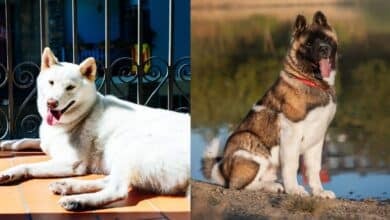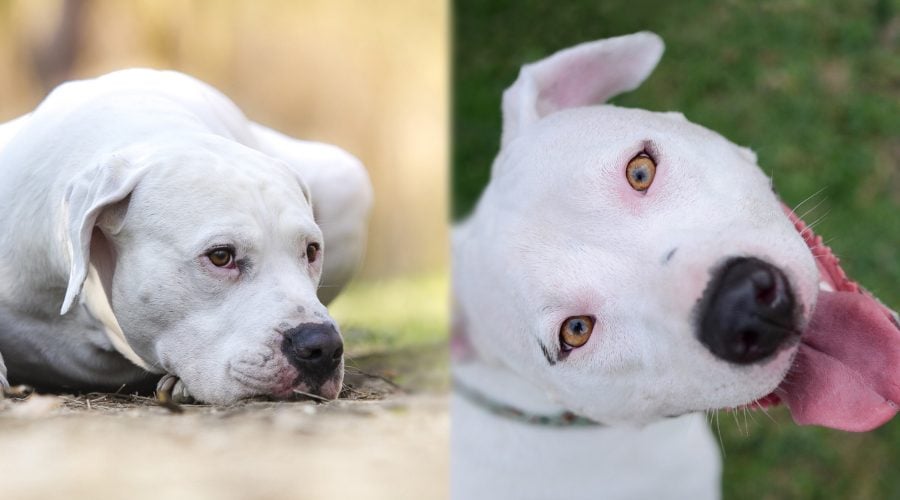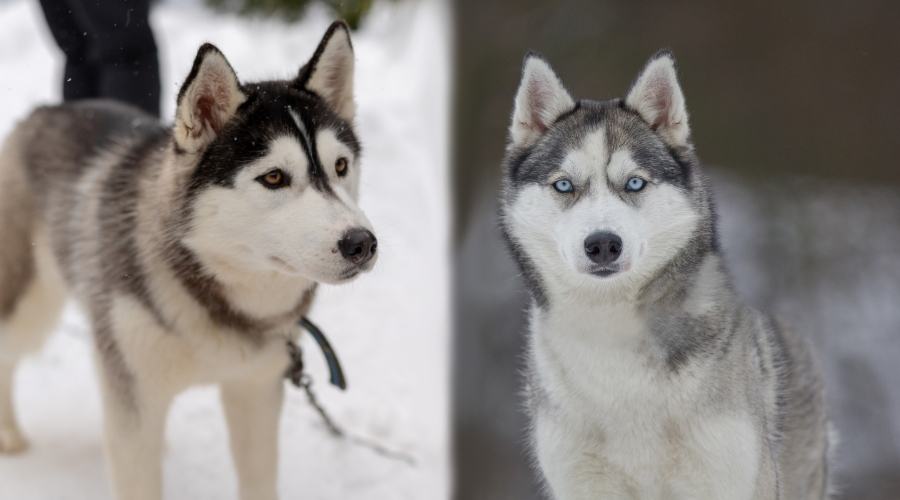Coyote vs Dog: Similarities & Differences
When you purchase through links on our site, we may earn a commission. Here’s how it works.
Coyotes and dogs are from the same family, which means they are distantly related. They both belong to the same genus, which is the canis genus. The scientific name for coyotes is canis latrans, whereas the scientific name for a dog is canis lupus familiaris. But despite this, there are many differences between them, more than similarities.
Table of Contents
There are 19 subspecies of coyotes, and the American Kennel Club (AKC) currently recognizes around 280 dog breeds. Some dogs, such as Huskies or other dog breeds resembling foxes, might look similar to their coyote cousins. Whereas some dogs, like the Pug, look nothing like coyotes. Dogs’ personalities differ because they have different breed purposes and because they are domesticated pets, whereas coyotes are wild animals and hunters.
This article closely examines the differences and similarities between coyotes and dogs. We explore their appearance, personality, health, diet, and habitat. Plus, we discover whether coyotes are trainable like dogs are, whether they can be domesticated, and more. So, let’s look at the comparison between coyotes and dogs.
Breed Comparison
- Scientific NameCanis latrans
- Scientific NameCanis lupus familiaris
- StatusWild animal
- StatusDomesticated pet
- Weight15 – 46 pounds
- Weight3 – 230 pounds
- AppearanceFoxy appearance, large triangle ears, golden eyes, lean body
- AppearanceWide variety of appearance depending on the specific breed
- HabitatNorth and Central America
- HabitatWorldwide
- LifespanRarely past 3 years
- Lifespan10 – 16 years
Appearance
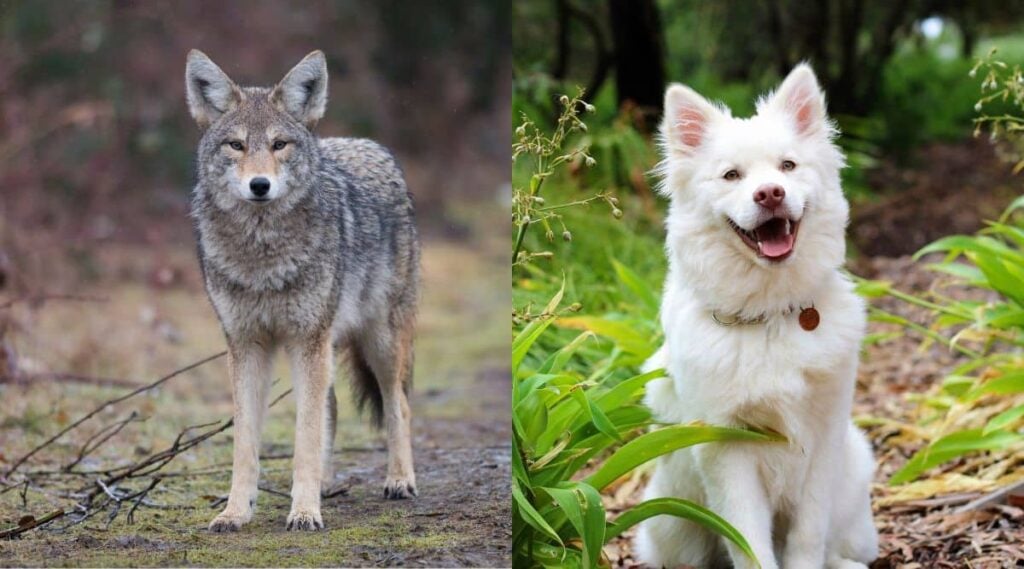
Male coyotes typically weigh between 18 and 46 pounds, and females weigh between 15 and 40 pounds. Making them smaller than their relative, the wolf. Dogs usually weigh between 3 pounds, such as Chihuahuas, and breeds, such as the English Mastiff, can weigh up to 230 pounds, sometimes more. Some dogs are broad and bulky, while others are long and lean.
Some dogs look like coyotes, like the Czech Wolfdog, whereas breeds like Dachshunds look nothing alike. Coyotes have a foxy appearance, with large triangular ears, golden eyes, and a long bushy tail. Their coats are usually a mixture of light gray, red, or fulvous, a dull orange to butterscotch color mixed with white and black. Colors usually vary by geographical location.
The coyote has a similar coat type to the Siberian Husky, which is very dense to keep them well insulated. There are countless dog coat colors, textures, and thicknesses across the different dog breeds, and not all are similar to the coyote. Some are hairless, and others have crazy curls, like the Poodle.
Temperament
There isn’t much research about the personality of coyotes, at least not as a pet. The primary focus of coyotes is to hunt for food and reproduce. However, a dog’s life also consists of belly rubs, fetching, watching a boxset with their master, and keeping them company. Coyotes are wild, and their personality reflects that, and dogs are pets with human-loving and fun characters.
We do know that, like most dogs, coyotes are social creatures and prefer to spend their time with other coyotes. Most dogs love spending time with their human pack, and many enjoy the company of other dogs. Coyotes form mutualistic hunting relationships with badgers, helping each other dig up rodent prey. Some coyotes have been observed laying their heads on their badger companion and licking them. There isn’t much chance of a dog and a badger getting along.
Coyotes are very vocal, so much so that the name coyote roughly translates to “barking dog.” They bark and howl to communicate with other pack members. Even the most vocal dogs, such as the Beagle, aren’t anywhere near as vocal as coyotes. This is another reason not to keep a coyote as a pet because it’d be a headache you’d never get rid of.
Habitat & Exercise
The coyote is native to North America and lives anywhere the coyote feels safe and can feed, such as in woodlands, mountains, and deserts. They tend to stay out of highly populated areas away from humans. Dogs are less flexible in their favored habitat and live inside the home with their humans. Most dogs do not like to live outdoors or away from their family. Unlike coyotes, dogs like to nap on the sofa and sleep in bed with us, enjoying a life of luxury.
Coyotes walk approximately 5 to 16 kilometers daily, mainly during the evening and twilight periods rather than during the day. This is to hunt and avoid encounters with humans. Coyotes in urban areas are more nocturnal when their hunting ground is less busy. Not many people know that coyotes are great swimmers too. When it comes to exercise, some dogs enjoy a quick walk around the block. Whereas other breeds, like the Catahoula Leopard Dog, are happy to work all day long. Unlike coyotes, dogs’ exercise needs vary drastically.
Health & Nutrition
Coyotes are generally healthy animals and have a lifespan of 13 to 15 years in captivity. Sadly, most wild coyotes die before their third birthday, and the two most common cause of death is collisions with vehicles or being shot. The lifespan of a dog depends on the breed. Typically, larger breeds have a shorter lifespan than smaller breeds, ranging from 10 to 16 years. Most dogs are well cared for as pets, meaning they usually live much longer than coyotes.
Coyotes are mainly carnivorous and usually eat rabbits, hares, rodents, deer, birds, and fish. They sometimes eat vegetables and fruits when meat is scarce. Dogs rely on us to feed them, so their diet consists of whatever food we choose. Dogs eat raw foods, freshly prepared foods, or convenient kibble containing a mixture of meat, carbs, fruits, veggies, and vitamins and minerals. It is rare for dogs to hunt wild animals and eat them.
Training & Domestication
Not all dogs are easily trained, but even the dumbest dog breeds are easier to train than wild coyotes. Even coyotes bred in captivity maintain a solitary and independent nature. Sure, they work well in groups to hunt, but they are less likely to follow human commands and aren’t interested in pleasing humans. Some dog breeds, like the Belgian Malinois, are so keen to please their master that it’s what they live for, making them super trainable.
Many dog owners wonder if they can domesticate a coyote, and although they possibly could to some degree, it wouldn’t be a great idea. They are wild animals and not reliable, safe, or trustworthy family pets. Just like the wolf and the dingo, another member of the canis family, they are challenging to domesticate. The bottom line is that if you’re after a family pet, a dog is a much better option than a coyote.
How Do Dogs & Coyotes Interact?
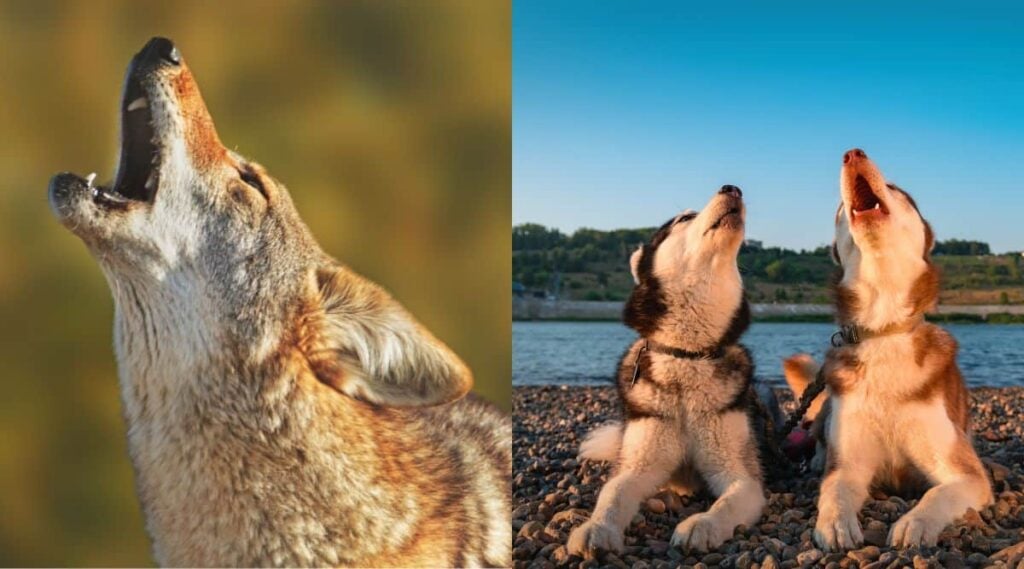
There is very little research into how dogs and coyotes interact because it is something you should avoid. Researchers from the University of California and the U.S. Geographical Survey studied clips available on YouTube, which were mainly surveillance videos capturing accidental interaction. They found that interactions between dogs and coyotes fell into antagonistic, playful, predatory, and uncategorized categories. Most interactions displayed canid sociality rather than highlighting a purely predator-prey relationship.
However, getting your dog to interact with a coyote in the name of research is not something you should try at home. Coyotes are dangerous, wild animals that you should avoid at all costs. The main way to avoid a coyote is to avoid walking in areas where they are known to be. But if you happen to come across a coyote when walking your dog, here are a few safety tips:
- If it’s safe, recall your dog and put them on a leash.
- Clap as loud as you can to scare the coyote away.
- Maintain eye contact and be as loud as possible to intimidate and scare it.
- Throw sticks or rocks at it.
- If this fails and the coyote comes towards you, back away slowly to escape the situation, but never turn your back on them or run.
Frequently Asked Questions
Are Dogs And Coyotes Related?
Yes, dogs and coyotes are related. They belong to the same genus, canis, and side by side, you can see the similarities between them. But because they are distant relations with entirely different habitats and lifestyles, their personalities are very different.
Can A Dog And A Coyote Breed?
The Urban Coyote Research Project (UCRP) states that although rare, coyotes and dogs can mate and have previously produced hybrid litters. Puppies of male coyotes and female dogs are known as coydogs, and a few have been raised in captivity. However, they are not as sociable as dogs and aren’t easily domesticated. Plus, it is illegal to own a canid hybrid in some states.
Coyote Vs. Dog: Who Would Win A Fight?
Who would win a fight depends on various factors, such as the animal’s size, age, strength, health, and the day in question. But generally, most dogs do not fare well against wild and vicious coyotes. However, a 20-month-old Great Pyrenees named Casper single-handedly killed eight coyotes protecting his master’s flock of sheep and chased three others away.
Final Thoughts
As you can see, coyotes and dogs have a few similarities. They are related and come from the same genus, their diet consists mainly of meat, they bark to communicate, and they enjoy a pack lifestyle. However, there are more differences than similarities, which mostly surround the basis that the coyote is a wild animal and the dog is a domesticated pet. If you are looking for a four-legged family pet, stick to a reliable doggo rather than a wild creature.
